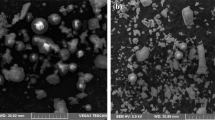Abstract
The properties of two types of fly ash geopolymers made from class F fly ashes produced in wet bottom and dry bottom boilers were investigated in the present study. The source material used in the geopolymer concrete was activated with sodium hydroxide and sodium silicate solution. The results revealed that the geopolymer produced with wet bottom boiler fly ash(CZ-FA)hardened quickly, and had higher early-age strength and lower shrinkage than the geopolymer produced with dry bottom boiler fly ash(SX-FA). The compressive strength of the two geopolymers made from CZ-FA and SX-FA was 45 MPa and 15 MPa respectively when cured at 60 °C and delayed for 14 d. However, after 90 days’ delay, the compressive strength of both the samples is almost the same, up to 80 MPa. Nearly 20% volume shrinkage of the samples made from SX-FA was much higher than that made from CZ-FA, which was almost zero. XRD, SEM/EDS and FT-IR were used to analyze the main reason of the differences.
Similar content being viewed by others
References
Guo X, Shi H, Dick W A. Compressive strength and microstructural characteristics of Class C fly ash geopolymer[J]. Cement and Concrete Composites, 2010, 32(2): 142–147.
Canfield G M, Eichler J, Griffith K et al. The role of calcium in blended fly ash geopolymers [J]. Journal of Materials Science, 2014, 49(17): 5922–5933.
Duxson P, Provis J L, Lukey G C et al. The role of inorganic polymer technology in the development of ‘green concrete’ [J]. Cement and Concrete Research, 2007, 37(12): 1590–1597.
Yildirim H, Sumer M, Akyuncu V et al. Comparison on efficiency factors of F and C types of fly ashes [J]. Construction and Building Materials, 2011, 25(6): 2939–2947.
Zheng L, Wang W, Shi Y. The effects of alkaline dosage and Si/Al ratio on the immobilization of heavy metals in municipal solid waste incineration fly ash-based geopolymer [J]. Chemosphere, 2010, 79(6): 665–671.
van Deventer J S, Provis J L, Duxson P et al. Reaction mechanisms in the geopolymeric conversion of inorganic waste to useful products [J]. J Hazard Mater, 2007, 139(3): 506–513.
Oh J E, Jun Y, Jeong Y et al. Characterization of geopolymers from compositionally and physically different Class F fly ashes[J]. Cement and Concrete Composites, 2014, 50: 16–26.
Jun Y, Oh J E. Mechanical and microstructural dissimilarities in alkali-activation for six Class F Korean fly ashes [J]. Construction and Building Materials, 2014, 52: 396–403.
Park Y M, Yang T Y, Yoon S Y et al. Mullite whiskers derived from coal fly ash[J]. Materials Science and Engineering: A, 2007, 454/455: 518–522.
Böke N, Birch G D, Nyale S M et al. New synthesis method for the production of coal fly ash-based foamed geopolymers [J]. Construction and Building Materials, 2015, 75: 189–199.
Oh J E, Monteiro P J M, Jun S S et al. The evolution of strength and crystalline phases for alkali-activated ground blast furnace slag and fly ash-based geopolymers [J]. Cement and Concrete Research, 2010, 40(2): 189–196.
Kramar S, Ducman V. Mechanical and microstructural characterization of geopolymer synthesized from low calcium fly ash [J]. Chemical Industry and Chemical Engineering Quarterly, 2015, 21(1): 13–22.
Palomo A, Blanco-Varela M T, Granizo M L et al. Chemical stability of cementitious materials based on metakaolin [J]. Cement and Concrete Research, 1999, 29(7): 997–1004.
Duxson P, Provis J L, Lukey G C et al. Understanding the relationship between geopolymer composition, microstructure and mechanical properties [J]. Colloids and Surfaces A: Physicochemical and Engineering Aspects, 2005, 269(1-3): 47–58.
Tishmack J K, Olek J, Diamond S. Characterization of high-calcium fly ashes and their potential influence on ettringite formation in cementitious systems [J]. Cement Concrete and Aggregates, 1999, 21(1): 82–92.
Li H, Zhuge L, Shi S et al. Hydration products of fly ash based cementing material activated by NaOH [J]. Journal of the Chinese Ceramic Society, 2012, 40(2): 234–239.
Rattanasak U, Chindaprasirt P. Influence of NaOH solution on the synthesis of fly ash geopolymer[J]. Minerals Engineering, 2009, 22(12): 1073–1078.
Ridtirud C, Chindaprasirt P, Pimraksa K. Factors affecting the shrinkage of fly ash geopolymers [J]. International Journal of Minerals, Metallurgy, and Materials, 2011, 18(1): 100–104.
Author information
Authors and Affiliations
Corresponding author
Rights and permissions
About this article
Cite this article
Du, H., Yang, L., Gao, W. et al. Effects of characteristics of fly ash on the properties of geopolymer. Trans. Tianjin Univ. 22, 261–267 (2016). https://doi.org/10.1007/s12209-016-2769-9
Accepted:
Published:
Issue Date:
DOI: https://doi.org/10.1007/s12209-016-2769-9




